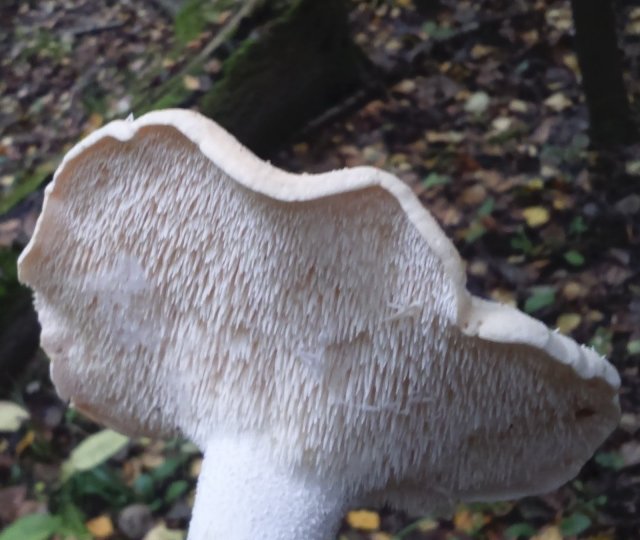White blackberry (Hydnum albidum)
- Division: Basidiomycota (Basidiomycetes)
- Subdivision: Agaricomycotina (Agaricomycetes)
- Class: Agaricomycetes (Agaricomycetes)
- Subclass: Incertae sedis (of uncertain position)
- Order: Cantharellales (Chanterella (Cantarella))
- Family: Hydnaceae (Blackberries)
- Genus: Hydnum (Gidnum)
- Type: Hydnum albidum (Herberry white)
:
- White dentine
- Hydnum repandum was. albidus

White Herringbone (Hydnum albidum) differs little from the more well-known brothers Yellow Hedgehog (Hydnum repandum) and Reddish Yellow Hedgehog (Hydnum rufescens). Some sources do not bother with separate descriptions for these three species, their similarity is so great. However, many sources note that white blackberry appeared (in Our Country) relatively recently.
head: White in different variations: pure white, whitish, whitish, with shades of yellowish and grayish. Blurred spots in the same tones may be present. The cap diameter is 5-12, sometimes up to 17 or even more, centimeters in diameter. In young mushrooms, the cap is slightly convex, with edges bent down. With growth, it becomes prostrate, with a concave middle. Dry, dense, slightly velvety to the touch.
Hymenophore: Spines. Short, whitish, whitish-pinkish, conical, pointed at the ends, densely spaced, elastic in young mushrooms, become very brittle with age, crumble easily in adult mushrooms. Slightly descend on the leg.
Leg: up to 6 in height and up to 3 cm wide. White, dense, continuous, does not form voids even in adult mushrooms.

Pulp: white, dense.
Smell: nice mushroomy, sometimes with some “floral” tint.
Taste: Taste information is quite inconsistent. So, in English-language sources it is noted that the taste of white blackberry is sharper than that of yellow blackberry, even sharp, caustic. speakers claim that these two species practically do not differ in taste, except that the yellow flesh is more tender. In overgrown specimens of blackberry, the flesh may become too dense, corky, and bitter. It is most likely that these differences in taste are associated with the place of growth (region, forest type, soil).
spore powder: White.
Spores are ellipsoid, not amyloid.
Summer – autumn, from July to October, however, this framework can shift quite strongly depending on the region.
It forms mycorrhiza with various deciduous and coniferous tree species, therefore it grows well in forests of various types: coniferous (prefers pine), mixed and deciduous. Prefers damp places, moss cover. A prerequisite for the growth of blackberry white is calcareous soil.
It occurs singly and in groups, under favorable conditions it can grow very closely, in large groups.
Distribution: North America, Europe and Asia. Massively distributed in countries such as, for example, Bulgaria, Spain, Italy, France. In Our Country, it is seen in the southern regions, in the temperate forest zone.
Edible. It is used in boiled, fried, pickled form. Good for drying.
According to some sources, it has medicinal properties.
It is very difficult to confuse a white hedgehog with some other mushroom: a whitish color and “thorns” are a fairly bright calling card.
The two closest species, the yellow blackberry (Hydnum repandum) and the reddish-yellow blackberry (Hydnum rufescens), differ in the color of the cap. Hypothetically, of course, a very light-colored form of lion’s mane (mature, faded) could be very similar to white lion’s mane, but since adult yellow mantle is not bitter, it will not spoil the dish.
White hedgehog, as a fairly rare species, is listed in the Red Books of some countries (Norway) and some regions of Our Country.









